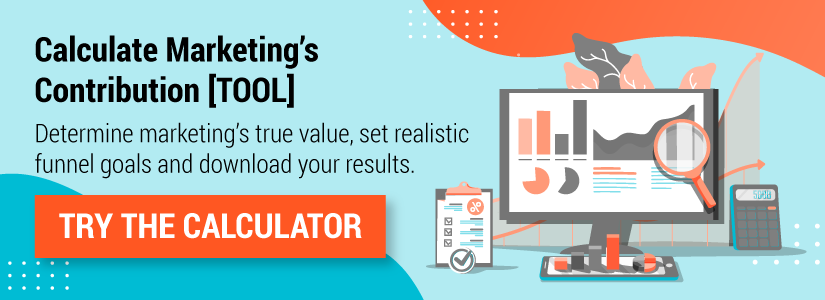Your marketing ROI is a measure of how much revenue marketing has generated versus how much you’ve spent on marketing. To ensure that marketing effectively contributes to business goals, you’ll want to keep your ROI high.
Here, we look at:
-
How to measure marketing ROI
-
8 ways to improve your inbound marketing ROI
-
Additional resources to help you take action
According to HubSpot, 40 percent of marketers said that proving the Return on Investment (ROI) of their marketing efforts is their biggest marketing challenge.
Your ROI is a measurement of how marketing has contributed to revenue versus the costs associated with marketing. Essentially, it tells you whether your marketing efforts have been profitable for your organization.
It’s absolutely crucial that, as a marketer, you’re able to speak to the ROI of your inbound marketing strategy so that you can determine if your efforts have been successful and adjust your strategy as needed. Knowing this measurement also allows you to easily communicate your impact on business goals to senior leadership and speak to the value of marketing.
Maybe you’re unsure what the ROI of your marketing activities is, or perhaps you know your ROI and it’s not where you want it to be. Either way, it’s important that you know how to calculate your inbound marketing ROI and how to improve it.
How to Calculate Inbound Marketing ROI
First and foremost, you need to understand how to measure your inbound marketing ROI so you can determine the impact your marketing activities have had on business goals. This will tell you if your end results were worth the effort.

To calculate your inbound marketing ROI, you’ll want to first subtract the costs associated with marketing from the revenue generated by marketing. Then, you’ll divide this number by the costs associated with marketing and multiply by 100 to convert this to a percentage.
For example, if marketing generated $100,000 in revenue for the period, and marketing activities cost the department $70,000, then your ROI would be about 43 percent.
How to Improve Your Marketing ROI
Of course, you’ll want your marketing ROI to be positive, meaning that you’re generating more money for your organization than you’re spending. Even if your ROI is positive, you might have benchmarks put in place that you’re still not quite reaching.
Luckily, there are certain things you can do as a marketer to boost the ROI of your efforts; let’s take a look at a few of them.
1. Set SMART goals for your marketing campaigns.
It seems obvious, but proper goal-setting is crucial to guarantee that your marketing efforts will be worthwhile.
SMART goals that are goals that are Specific, Measurable, Attainable, Relevant, and Time-bound. With SMART goals in place, your team knows what needs to be accomplished, when it needs to be accomplished, and how to know if the job is done.
An example of a SMART goal might sound something like this: “Increase our rank in organic search results from 10th to 1st for the keyword ‘marketing goals’ by the end of the month by optimizing existing content.”
Your marketing team will know what the task at hand should be and won’t waste any time wondering what should be done or how to do it.
SMART goals allow you to maximize efficiency and ensure that marketing tasks are being completed on schedule. This will make your campaigns more data-driven and profitable, contributing to a higher ROI.
Additional Resources:
- How to Set SMART Marketing Goals [Free Template]
- Using SMART Goals to Enhance Your Inbound Marketing Strategy
2. Identify and track the appropriate KPIs for your campaigns.
Another simple way to improve your marketing ROI is by consistently monitoring your progress against Key Performance Indicators (KPIs). KPIs are quantifiable metrics that gauge your performance against your goals.
Tying this back to setting SMART goals for your campaigns, you need to identify metrics that will tell you whether you’re on track to meet your goals. By tracking these metrics, you’re able to pivot your strategy as needed and avoid wasting time on tactics that are not moving the needle.
For the SMART goal mentioned previously, important KPIs might be Average Rank and Website Sessions. If you notice that these metrics are not improving with your marketing efforts, you’ll be able to quickly shift your focus and adjust your strategy accordingly. This eliminates both wasted time and money, leading to a higher marketing ROI.
To automatically track all of your KPIs in a convenient dashboard, we recommend using a tool like Databox.

Additional Resources:
- 9 KPIs that Every Content Marketer Needs to Track
- The Top 10 Email Marketing KPIs to Measure Campaign Success
3. Put in place a process for marketing attribution.
It’s often difficult for marketers to determine whether a deal originated from the efforts of marketing or sales. Some of marketing’s contribution can be incorrectly attributed to the sales team, making your ROI seem lower than it truly should be.
Use our Marketing Contribution Calculator
An easy-to-use, marketing contribution calculator that will automatically set your targets for you.
Your CRM can be helpful in ensuring that marketing’s contribution to revenue is clearly outlined. For example, in HubSpot’s CRM, you can trace back a contact in your database to their initial interaction with your company. There’s no confusion as to where they came from; you’ll see whether they originated from organic search, a cold call, an event, etc. You can even look further to see the specific page that they viewed or CTA that they clicked.

Knowing how to trace deals back to marketing’s efforts will improve marketing’s ROI by guaranteeing that the marketing department gets credit for all revenue that was generated through their efforts.
Additional Resources:
4. Automate processes within your CRM.
Marketers today have incredible technology at their fingertips that can save them time and money that would otherwise be spent on repetitive and tiresome tasks. One of the easiest ways to improve your marketing ROI is actually to automate some of these tasks within your CRM or other marketing software.
Our favorite way to automate tasks is by using workflows within the HubSpot Marketing software. By creating workflows, you’re able to automate email and lead nurturing tasks that would typically take you hours to complete manually.

For example, if a website visitor downloads a content offer and submits a form you’ll typically want to follow up with this lead via email later on. Rather than assigning these emails to someone on the marketing team, you can create a workflow within HubSpot to automatically send follow up emails to new leads that submitted the form.
Automation frees up time that can be spent on more valuable marketing tasks and ultimately saves your organization money. It’s a surefire way to improve your marketing ROI over time.
Additional Resources:
- 7 HubSpot Marketing Automation Workflows That Will Keep Your CRM Running Squeaky Clean
- The Right and Wrong Way to Do Email Automation
5. Revisit and reconsider your target audience.
You can have a beautifully done marketing strategy, but if you’re not reaching the right audience it’s all in vain.
Targeting the wrong audience will mean that your campaigns will have poor conversion rates and be ineffective at both lead generation and customer acquisition. This is a common pitfall for many marketers that can ultimately contribute to a negative ROI.
To ensure that your content is reaching the right audience, you’ll want to create detailed buyer personas before implementing your marketing campaigns. Buyer personas are semi-fictional representations of your ideal buyer. They outline the challenges and questions that the persona might face, making it easier for you to create content that is valuable to this audience.

By strategizing with your buyer personas in mind, you’re able to ensure that your efforts are going to resonate with the target audience. This will make it more likely that they will convert and boost your marketing ROI.
Additional Resources:
- Buyer Persona Template: What Goes Into a Great Persona
- 4 Steps to Creating More Accurate Student Personas
6. Make sure you’re following SEO best practices.
According to a 2018 poll by Search Engine Journal, nearly 50 percent of respondents agreed that organic search is the digital marketing channel with the highest ROI for their organization.
Let’s say you have a brilliant content marketing strategy, but your company’s website is full of errors, both on-screen and off-screen. To get your organization’s website ranking high in organic search results, it’s imperative that you follow SEO best practices to improve both user experience and crawlability.
If your marketing ROI is not where you would like it to be, you should first scan your Google Search Console account for any errors. Then, you’ll want to crawl your website using a tool like SEMrush’s Site Audit feature to identify any issues that might be negatively impacting your website’s SEO.

By maintaining an SEO-friendly website, you’ll rank higher in organic search results and improve the ROI of your digital marketing efforts since you’ll be reaching a larger audience.
Additional Resources:
7. Try out different marketing channels.
You don’t want to put all your eggs in one basket, especially not with marketing. A marketing strategy that integrates many different channels is likely to have a positive ROI.
There are many high-value marketing channels that you’ll want to use if you’re not already. For example, email marketing generates about $44 for every $1 spent, making it one of the most valuable marketing channels you can utilize. Further, you might want to give content marketing a try; according to HubSpot, 82 percent of marketers who blog consistently see a positive ROI.
It’s always a good idea to try a different approach to marketing if your results aren’t satisfactory. Implementing an integrated strategy between multiple channels will ultimately help to boost your marketing ROI and make your efforts worthwhile.
Additional Resources:
8. Hire an inbound marketing agency.
As a marketer, you’re busy. You may have already identified the inefficiencies in your marketing strategy that are eating up your time and wasting resources, but now the problem is that you don’t have the time to make the necessary adjustments.
Although it might sound scary, hiring an inbound marketing agency can be one of the best long-term investments you can make. It often costs more to hire a new marketing team member than it does to work with an agency.

Further, no one is an expert in every marketing channel or methodology. By hiring a team of experts who are well versed in the inbound methodology, you can then focus your time on the areas that you do consider yourself an expert in.
Ultimately, hiring an inbound marketing agency will improve your marketing ROI dramatically.
Additional Resources:
- How Hiring an Inbound Marketing Agency Saves Your Business Money
- What to Expect When Working With an Inbound Marketing Agency
Maximizing Your Marketing ROI
At the end of the day, your marketing efforts need to tie back to business goals and generate revenue for your company. If the costs of marketing outweigh the revenue that it brings in, your efforts aren’t effectively contributing to business goals. A positive ROI is a good indication that marketing is effective and highly valuable to your organization.
To get a better idea of how your marketing efforts should impact business goals, use our free Marketing Contribution Calculator.










